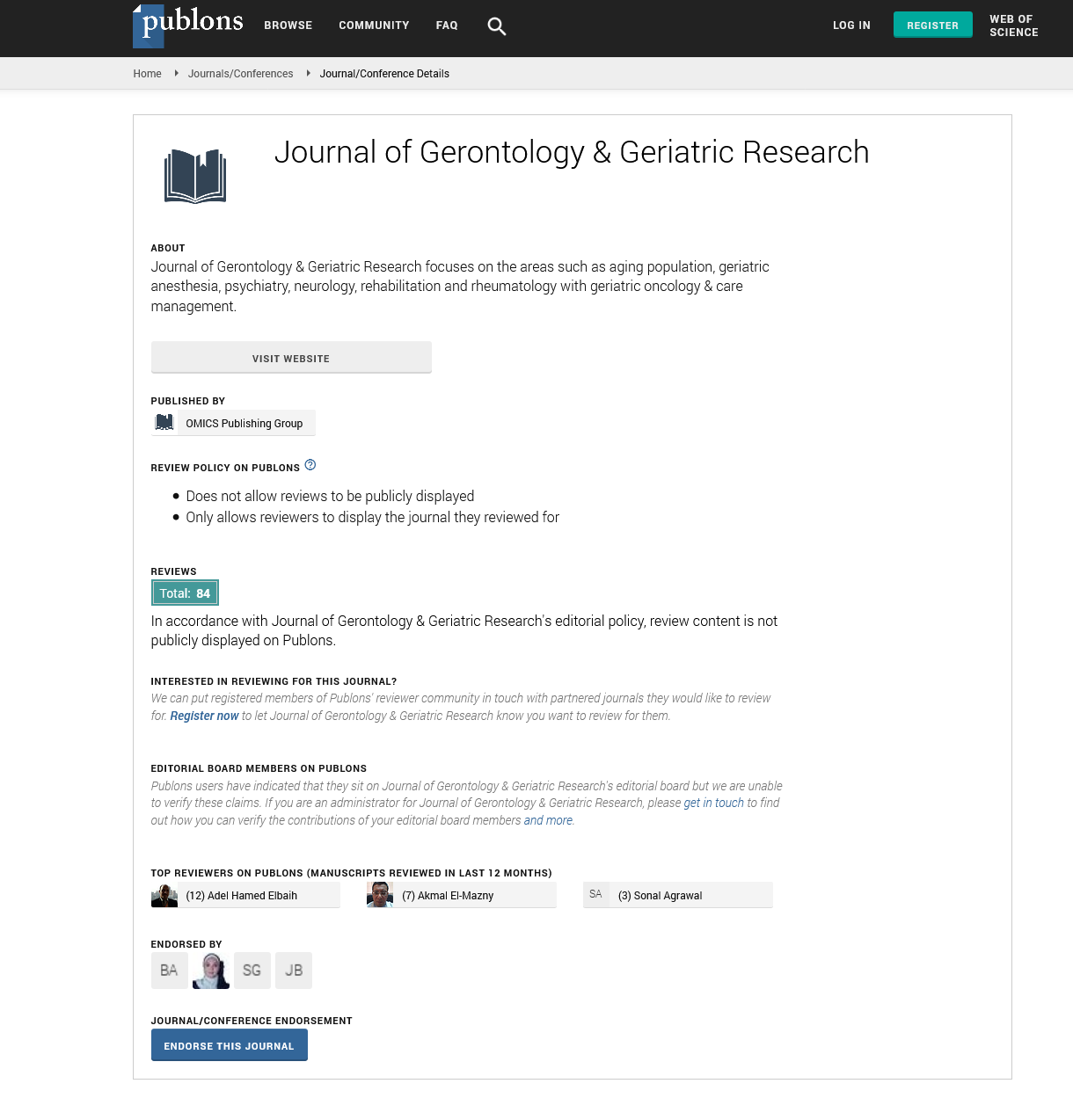PMC/PubMed Indexed Articles
Indexed In
- Open J Gate
- Genamics JournalSeek
- SafetyLit
- RefSeek
- Hamdard University
- EBSCO A-Z
- OCLC- WorldCat
- Publons
- Geneva Foundation for Medical Education and Research
- Euro Pub
- Google Scholar
Useful Links
Share This Page
Journal Flyer

Open Access Journals
- Agri and Aquaculture
- Biochemistry
- Bioinformatics & Systems Biology
- Business & Management
- Chemistry
- Clinical Sciences
- Engineering
- Food & Nutrition
- General Science
- Genetics & Molecular Biology
- Immunology & Microbiology
- Medical Sciences
- Neuroscience & Psychology
- Nursing & Health Care
- Pharmaceutical Sciences
Commentary - (2022) Volume 11, Issue 10
Relationship in Subacute Stroke Patients between Serum BDNF Levels and Depressive Mood
Ahee Simard*Received: 03-Oct-2022, Manuscript No. jggr-23-19568; Editor assigned: 06-Oct-2022, Pre QC No. P-19568; Reviewed: 18-Oct-2022, QC No. Q-19568; Revised: 22-Oct-2022, Manuscript No. R-19568; Published: 29-Oct-2022, DOI: 10.35248/2167-7182.2022.11.639
Description
This pilot study sought to determine if serum brain-derived neurotrophic factor may serve as a biomarker for post-stroke depression in subacute stroke patients. The research enrolled 38 individuals who had subacute strokes. The usual rehabilitation programme, which consisted of of physical therapy each day of occupational therapy five days a week, was completed by all participants. During the subacute stroke phase, the rehab period lasted two weeks. Before, one, and two weeks following the normal rehabilitation programme, we examined the blood levels of and matrix metalloproteinase- Additionally, the Geriatric Depression Scale-Short Form was used to evaluate depressed mood in all individuals at three different times. To ascertain the connection between blood BDNF levels and other variables, Pearson correlation analysis was used. F levels and the demonstrated a considerable improvement over the course of the typical rehabilitation treatment. At each time point, the strongly linked with the serum. According to these findings, serum B may be employed as a biomarker for sad mood in subacute stroke patients. To fully understand these findings, however, more research involving larger study groups is required [1,2].
One of the leading global causes of severe, permanent impairment is stroke. The burden of impairment is projected to become a more significant public health problem as the frequency of stroke rises. To lessen the burden of post-stroke impairment, appropriate healthcare services should be activated. To minimise the early effects of a stroke, take precautions to prevent subsequent problems, and optimise functional abilities via intensive rehabilitation therapy are the current best practises in stroke care. The most common mental condition affecting around one third of stroke survivors is post-stroke depression, with a cumulative incidence of The natural course of had an aphasic pattern, with an increase in depressed symptoms within the first six months, according to a new review paper.
Despite the therapeutic significance of, it is difficult for clinicians to identify depressed symptoms in stroke patients early and accurately. It might be particularly challenging to identify melancholy mood in stroke patients who have cognitive or linguistic functioning deficits. According to some publications, finding particular biomarkers may boost the sensitivity of diagnosing. Based on the pathophysiological underpinnings of those investigations suggested the potential efficacy of specialised targeted The most prevalent neurotrophic in the brain, brain-derived neurotrophic factor has been shown to influence processes linked to longterm depression and long-term potentiation that are N-methyl-Daspartate receptor dependent Major depressive disorder is thought to have a pathophysiology that includes [3-5].
Conclusion
Twelve subacute stroke patients were unable to complete the survey because it required better cognitive and linguistic abilities. This could have influenced the study's results, however biomarkers in can rule out this theory. Additionally, we were unable to adjust for age, sex, stroke severity, lesion characteristics, and current medication as well as measure depressed mood throughout the chronic stroke phase. In particular, we were unable to take into account the connection between serum levels and other functional deficits such motor and cognitive impairments in stroke patients. Therefore, more research including more stroke victims will be required in the future. Despite these drawbacks, this study's findings imply that serum might be employed as a biomarker for depression.
References
- Taherkhani A. Chronic kidney disease: A review of proteomic and metabolomic approaches to membranous glomerulonephritis, focal segmental glomerulosclerosis, and IgA nephropathy biomarkers. Proteome Sci. 2019; 17:1-8.
- Feigin VL. Global burden of stroke and risk factors in 188 countries, during 1990–2013: a systematic analysis for the Global Burden of Disease Study 2013. The Lancet Neurol. 2016; 15: 913-924.
- Bulow RD. Extracellular matrix in kidney fibrosis: more than just a scaffold. J Histochem Cytochem. 2019; 67: 643-661.
- Kuppe C. Decoding myofibroblast origins in human kidney fibrosis. Nature2021; 589: 281-286.
- Barbara NP. Endoglin is an accessory protein that interacts with the signaling receptor complex of multiple members of the transforming growth factor-β superfamily. J Biol Chem. 1999; 274:584-594.
Google Scholar, Crossref, Indexed at
Google Scholar, Crossref, Indexed at
Google Scholar, Crossref, Indexed at
Google Scholar, Crossref, Indexed at
Citation: Simard A (2022) Relationship in Subacute Stroke Patients between Serum BDNF Levels and Depressive Mood. J Gerontol Geriatr Res. 11: 639.
Copyright: © 2022 Simard A. This is an open-access article distributed under the terms of the Creative Commons Attribution License, which permits unrestricted use, distribution, and reproduction in any medium, provided the original author and source are credited.

